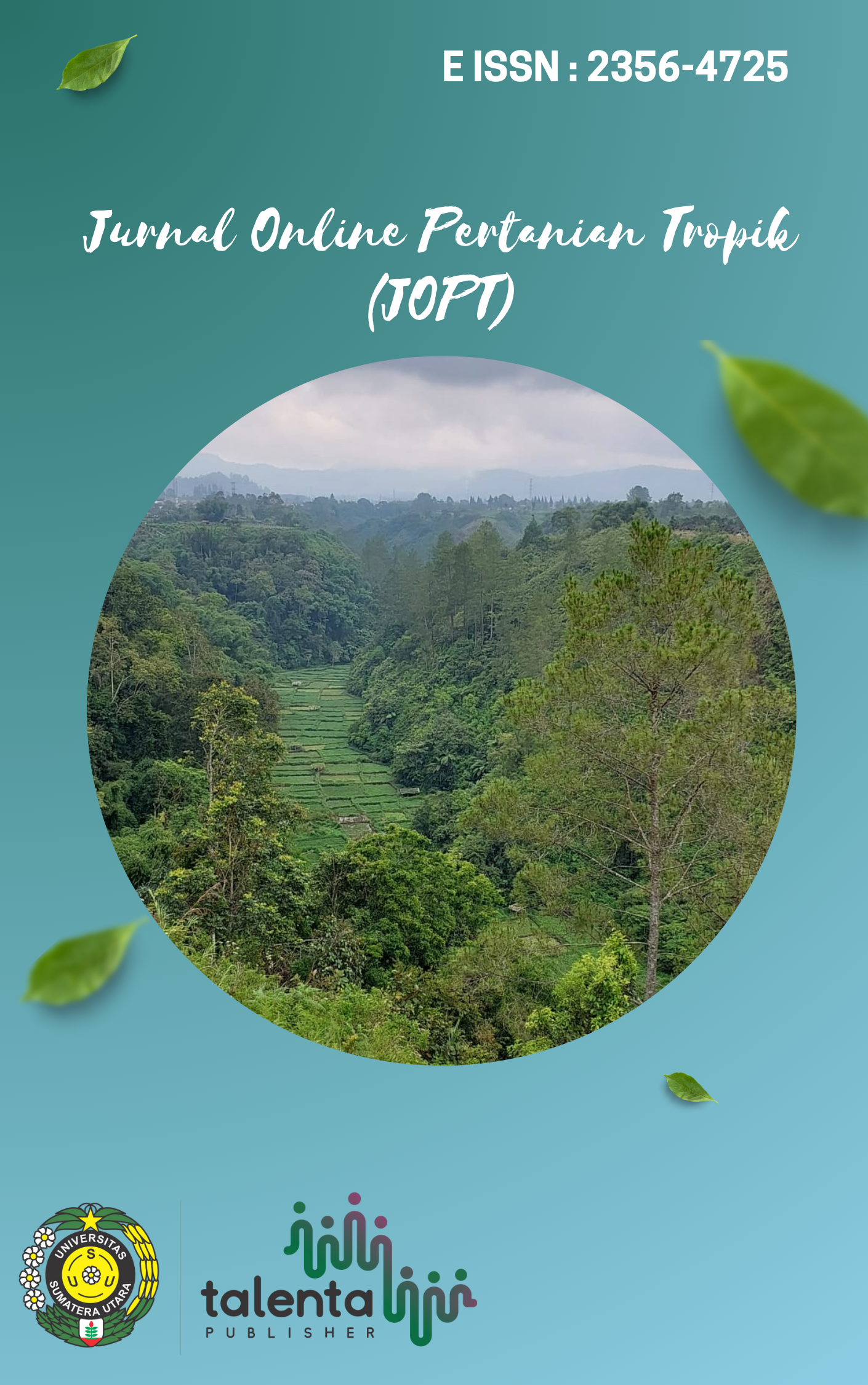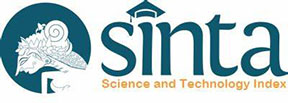Effectiveness of Pest Control of Cocoa Fruit (Conopomorpha cramerella as) Using Pruning and Vegetable Insecticide Treatment on Cocoa (Theobroma cacao L)
Effectiveness of Pest Control of Cocoa Fruit (Conopomorpha cramerella as) Using Pruning and Vegetable Insecticide Treatment on Cocoa (Theobroma cacao L)
DOI:
https://doi.org/10.32734/jopt.v9i2.9053Keywords:
Keywords : PBK (Cocoa Fruit Borer), Vegetable Insecticides, PruningAbstract
The sustainability of cocoa production in Indonesia is faced with the problem of the cocoa pod borer (Theobroma cacao L.). In an effort to control the main pests on cocoa plants, various techniques can be used, namely control with the use of natural insecticides and control by technical culture in the form of pruning. Natural insecticide is an insecticide whose basic ingredients come from plants that are easilybiodegradablein nature, so they do not pollute the environment and are relatively safe for humans and livestock, because the residue is easily lost. Pruning is the act of removing part of the plant organs in the form of branches, twigs and leaves with the aim of obtaining good cocoa plant branches, regulating the distribution of production branches and leaves so that they are evenly distributed, removing unwanted plant parts, stimulating the plants to grow. form new organs, reduce the risk of pest and disease attacks, and increase the ability of plants to form fruit. The purpose of this study was to determine the response of the application of botanical insecticides and pruning to the control of the cocoa pod borer (Theobroma cacao L.). The experimental design used a non-factorial randomized block design consisting of 7 treatments. The treatment of vegetable insecticides consisted of 4 levels, namely I0 (Without insecticide = Control), I1 (vegetable insecticide made from srikaya seeds at a dose of 250 ml/liter of water), I2 (vegetable insecticide made from tuba root with a dose of 250 ml/liter water), I3 (vegetable insecticide made from tobacco leaves at a dose of 250 ml/liter of water). The pruning treatment consisted of 3 levels, namely I4 (Without Pruning (Control), I5 (Pruning Interval 7 days after the study) and I6 (Pruning Interval 14 days after the study). Observations consisted of attack intensity, level of damage caused by PBK attack, attack index and production Control of the cocoa pod borer by pruning and botanical insecticides on cocoa plants showed a significant effect on the parameters of attack intensity and level of damage at the age of 6 weeks, and the attack index at the age of 12 weeks. 2 msp, 4 msp, 8 msp, 10 msp, 12 msp, and the parameters of the level of damage at the age of 2 msp, 4 msp, 8 msp, 10 msp, 12 msp and the plant production parameters at the age of 12 msp showed no significant effect.
Downloads
References
Abadi, L. 2003. Plant Diseases. Bayu Media Publishing. Poor. Ahmadi, Abu, 2004. Research Methods. Earth Literature. Jakarta
Chairani Hanum, 2008. Plant cultivation techniques volume 3 for SMK. Directorate of Vocational School Development, Directorate General of Primary and Secondary Education Management, Ministry of National Education.
Joko Widodo. 2008. Brown Disease Pest. PT Pustaka Buana, Bandung.
Endah and Novijon, 2002. Controlling Pests and Plant Diseases. Agro Media Library. Jakarta
Firdausil AB, Nasriati, Alvi Yani, 2008. Cocoa Cultivation Technology. Agency for Agricultural Research and Development. Agro Invasion.
Hartati, Z. 2002. Testing Soursop Leaf Seed Extract to Control Helicoverpa armigera Pests. AgroMedia Library. Jakarta
Haryanto, ET Suhartini and E. Rahayu. 2000. Cultivation of Cacao Plants. PT. Penebar Swadya. Jakarta
Kardinan, A. and M. Iskandar. 2007. Effect of various types of plant extracts as vegetable molluscicides on the golden snail (Pomacea canaliculata). Indonesian Journal of Plant Protection.
Cardinan. 2002. Vegetable Pesticide Herbs and Applications. Jakarta: Self-Help Spreader.
Nusyirwan Ismail, 2009. Attractive Prospects for Investment in Cocoa Cultivation. Regional Licensing and Investment Board of East Kalimantan Province.
Pracaya. 2007. Pests and Plant Diseases. Jakarta: Self-Help Spreader.
Samsudin, 2008. Plant Resistance to Insect Pests. Jakarta: Bumi Aksara Siregar, THS, 2008. Cultivation, Processing and Marketing of Chocolate. Self-Help Spreader.
Sri Mulato et al, 2005, Cocoa Primary and Secondary Product Processing, Indonesian Coffee and Cocoa Research Center, Jember.
Sudarsono. 2006. Neem Seed Extract as a Vegetable Pesticide: Potential, Constraints, and Development Strategies. Perspektif Vol. 8 No. 2 / December 2009. Pages 115 – 176.
Sukamto, S. 2007. Introduction and Control of Pests and Diseases of Cocoa Plants. Indonesian Coffee and Cocoa Research Center. Printed by Megah Offset Arjasa, Jember.
Sulistyowati, E. 2010. Complete Guide to Cocoa Cultivation. Self-Help Spreader. Jakarta Susanto FX, 2004. Cocoa Crops Cultivation and Processing Results. Kanisius, Yogyakarta.
Shakir. M, 2010. Cultivation and Post Harvest Cocoa. Plantation Research and Development Center. Bogor
Tumpal HS Siregar, Slamet Riyadi, Laeli Nuraeni. 2012. Cultivation of Chocolate. Self-Help Spreader. Jakarta.
Untung, K. 2006. Hand Out Lecture on the Basics of Plant Protection. Faculty of Agriculture, Gadjah Mada University, Yogyakarta.
Wardojo. 2001. Brown Plant Insect Pest. Plantation Research Institute. Bogor. Yatim, W. 2003. Cacao Cultivation Techniques, CV. Tarsito : Bandung.
Zaenudin, 2010. Smart Book on Cocoa Cultivation. AgroMedia Library. Jakarta.
Downloads
Published
How to Cite
Issue
Section
License
Copyright (c) 2022 Jurnal Pertanian Tropik

This work is licensed under a Creative Commons Attribution-ShareAlike 4.0 International License.






















